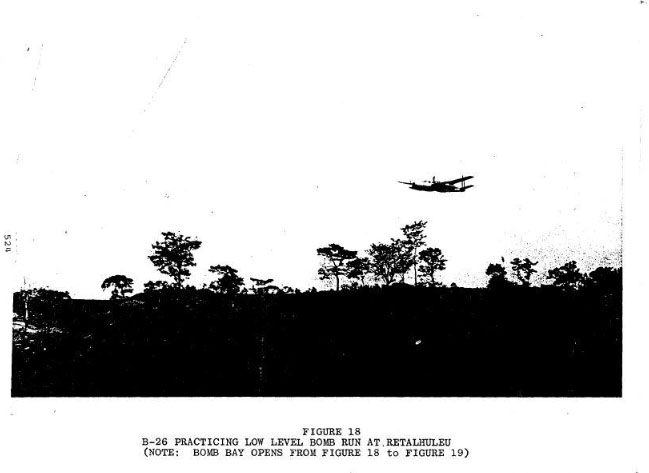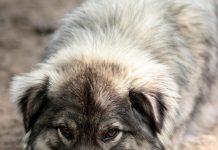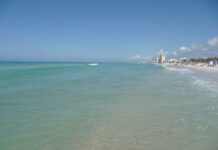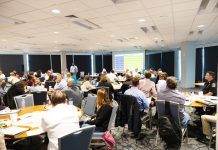Esta historia es originada por Northwest Florida Daily News: http://www.nwfdailynews.com/news/20161128/eglin-afb-vs-castro-history
Por Kelly Humphrey | 315-4443 | @Kellyhnwfdn | khumphrey@nwfdailynews.com |
No es ningún secreto que en los primeros años después de que Fidel Castro derrocó al gobierno cubano en 1959, los líderes militares y de inteligencia norteamericana estaban ansiosos de derrocar al dictador cubano. Ya que una vez los documentos secretos han sido desclasificados con el tiempo, se ha puesto de manifiesto que al menos dos de esos esfuerzos tenían conexiones con el Eglin Air Force Base (en Fort Walton Beach), y en particular con Duke Field.
Tal vez el intento más famoso fue la invasión del Bay of Pigs (Invasión de Playa Girón, o Invasión de Bahía de Cochinos, o Batalla de Girón) en abril de 1961. El plan era atacar a la Fuerza Aérea Cubana con bombarderos B-26 disfrazados estadounidenses, y luego invadir a guerrilleros de la costa sur de la isla en una zona conocida como Bay of Pigs. Ambos esfuerzos fracasaron, sin embargo, las fuerzas de Castro mataron a 114 de los invasores y capturaron más de 1.000.
Aunque se ha informado de que los B-26 usados en el esfuerzo fueron “desinfectados” – otro término para tener toda su identificación americana eliminada – en Duke Field, algunos informes dicen que los pilotos cubanos exiliados realmente recibieron entrenamiento en el campo auxiliar de Eglin.
Uno de los hombres que afirmó haber entrenado a los tripulantes aereos fue James Storie, quien escribió sobre su experiencia en la revista “Air and Space.” Recordó haber sido reclutado para una misión secreta especial a principios de 1961.
“Estaríamos entrenando a exiliados cubanos para volar los B-26 para una invasión de Cuba, con el objetivo de desencadenar una revolución que derrocaría al dictador comunista Fidel Castro,” escribió Storie. “Después de una semana de informes y papeleo, informamos al Eglin Air Force Base a medianoche … (en un avión) con ventanas oscurecidas, volando a 50 pies sobre el agua por un tiempo muy largo.”
Storie dijo que en un momento había tantos como 18 bombarderos B-26 en la base. Su equipo pasó cerca de una semana practicando y preparando, y en la mañana del 15 de abril de 1961, ocho B-26s piloteados por pilotos cubanos despegaron en el primero de lo que se suponía era varios ataques de bombardeo.
“Después del primer bombardeo, Washington envió un mensaje para detenerse hasta nuevo aviso,” escribió Storie. “El período de calma duró tres días, luego se intentó otro bombardeo. (Pero) nuestros B-26 no tenían ninguna posibilidad contra (las fuerzas de Castro). It was a turkey shoot.”
El doctor Alfred Cuzan, un distinguido profesor de ciencias políticas de la University of West Florida, huyó de Cuba con su familia apenas una semana antes de la invasión del Bay of Pigs. Aunque tenía sólo 11 años en ese momento, creció escuchando historias sobre la desaventura por uno de sus tíos, que participó en la misión.
Cuzan dijo que la invasión estaba condenada al fracaso desde el principio.
“Los Estados Unidos querían una negación plausible sobre su participación, por lo que utilizaron el avión más antiguo y trataron de disimularlos,” el dijo. “Las fuerzas de inteligencia de Castro le dijeron exactamente cuándo iban y cuántas personas tenían. Tenían aviones mucho más nuevos y miles de soldados armados. Los llamados invasores no tuvieron la oportunidad.”
El fracaso de la misión del Bay of Pigs no impidió que el Pentágono y la CIA buscaran otras maneras de derrocar o incluso asesinar a Castro. De acuerdo con un memorándum desclasificado del 13 de marzo de 1962 del Joint Chiefs of Staff, Eglin estuvo involucrado en uno de varios planes diseñados para proporcionar una excusa para un ataque militar estadounidense contra Cuba.
El plan, con el nombre de código “Operation Mangoose,” involucró varios escenarios posibles, incluyendo un falso incidente en el que parecía que los aviones de combate cubanos habían derribado un avión estadounidense.
“Un avión en Eglin AFB sería pintado y numerado como un duplicado exacto para un avión … (fuera de) el área de Miami,” decia el memorándum.
Según el plan, el avión civil despegaría con varios pasajeros escogidos a mano. El avión descendería a una altitud mínima y aterrizaría directamente en un campo auxiliar en Eglin. Los pasajeros serían evacuados y el avión duplicado seguiría en el plan de vuelo pre-archivado de la aeronave original.
“Cuando estubiera sobre Cuba, el drone … (transmitiria) un mensaje del ‘May Day’ declarando que fue atacado por aviones cubanos,” decia el memorándum. El drone sería entonces destruido por control remoto.
Por alguna razón, el plan, y varios otros descritos en el memorándum, nunca fueron implementados.
Cuzan dijo que no culpa al gobierno estadounidense de intentar derrocar a Castro. Solo deseaba que lo hubieran hecho bien la primera vez.
“Tras el fiasco de Bay of Pigs, los Estados Unidos continuaron apoyando la insurrección en Cuba,” el dijo. “Deberían haberlo hecho correctamente al ir en su totalidad a retirarlo, en lugar de estas medidas a medias. El daño que Castro hizo a Cuba y toda América Latina fue desastrosa. Planteó semillas de terrorismo en la región.”
“Hemos pagado un alto precio porque no lo cortamos de raiz al principio.”
Eglin AFB vs. Castro: a history
This story originated Northwest Florida Daily News: http://www.nwfdailynews.com/news/20161128/eglin-afb-vs-castro-history
By Kelly Humphrey | 315-4443 | @Kellyhnwfdn | khumphrey@nwfdailynews.com

It’s no secret that in the early years after Fidel Castro overthrew the Cuban government in 1959, American military and intelligence leaders were eager to topple the Cuban dictator. As once top-secret documents have been declassified over time, it’s become clear that at least two of the those efforts had connections to Eglin Air Force Base (en Fort Walton Beach), and in particular, Duke Field.
Perhaps the most famous effort was the Bay of Pigs invasion in April 1961. The plan was to attack the Cuban Air Force using disguised American B-26 bombers, then have guerrilla fighters invade the southern shore of the island in an area known as the Bay of Pigs. Both efforts failed, however, and Castro’s forces killed 114 of the invaders and captured more than 1,000.
While it’s long been reported that the B-26s used in the effort were “sanitized” — another term for having all of their American identification removed — at Duke Field, some reports say that the Cuban exile pilots actually received training at the Eglin auxiliary field.
One of the men who claimed to have trained the air crews was James Storie, who wrote about his experience in Air and Space Magazine. He recalled being recruited for a special, top secret mission in early 1961.
“We would be training Cuban exiles to fly B-26s for an invasion of Cuba, with the goal of triggering a revolution that would overthrow communist dictator Fidel Castro,” Storie wrote. “After a week of briefings and paperwork, we reported to Eglin Air Force Base at midnight … (in a plane) with blacked out windows, flying 50 feet above the water for a very long time.”
Storie said that at one time there were as many as 18 B-26 bombers at the base. His team spent about a week practicing and preparing, and on the morning of April 15, 1961, eight B-26s flown by Cuban pilots took off in the first of what was supposed to be several bombing raids.
“After the first bomb run, Washington sent word to stand down until further notice,” Storie wrote. “The lull lasted three days, then another bomb run was attempted. (But) our B-26s had no chance against (Castro’s forces). It was a turkey shoot.”
Dr. Alfred Cuzan, a distinguished professor of political science at the University of West Florida, fled Cuba with his family just a week before the Bay of Pigs invasion. Although he was just 11 years old at the time, he grew up hearing stories about the misadventure from one of his uncles, who took part in the mission.
Cuzan said the invasion was doomed to failure from the beginning.
“The U.S. wanted plausible deniability about their involvement, so they used the older aircraft and tried to disguise them,” he said. “It was silly. Castro’s intelligence forces told him exactly when they were coming and how many people they had. He had much newer aircraft and had thousands of armed troops. The so-called invaders didn’t have a chance.”
The failure of the Bay of Pigs mission didn’t deter the Pentagon and the CIA from looking for other ways to overthrow — or even assassinate — Castro. According to a March 13, 1962, declassified memo from the Joint Chiefs of Staff, Eglin was involved in one of several plans designed to provide an excuse for an American military attack on Cuba.
The plan, code-named “Operation Mongoose,” involved several possible scenarios, including a fake incident in which it would appear that Cuban fighter jets had shot down an American airplane.
“An aircraft at Eglin AFB would be painted and numbered as an exact duplicate for an aircraft … (out of) the Miami area,” the memo stated.
According to the plan, the civilian plane would take off with several handpicked passengers. The plane would then descend to a minimum altitude and land directly at an auxiliary field at Eglin. The passengers would be evacuated, and the duplicate drone aircraft would continue on the original aircraft’s pre-filed flight plan.
“When over Cuba, the drone will … (transmit) a ‘May Day’ message stating that it was under attack by Cuban … aircraft,” the memo stated. The drone would then be destroyed by remote control.
For whatever reason, the plan, and several others outlined in the memo, were never implemented.
Cuzan said he doesn’t fault the American government from attempting to overthrow Castro. He just wishes they had gotten it right the first time.
“Following the Bay of Pigs fiasco, the U.S. continued to support insurrection in Cuba,” he said. “They should have done it correctly by going full-force at removing him, instead of these halfhearted measures. The damage that Castro did to Cuba and all of Latin America was disastrous. He planted seeds of terrorism through the region.
“We’ve paid a high price because we didn’t nip him in the bud in the beginning.”

















